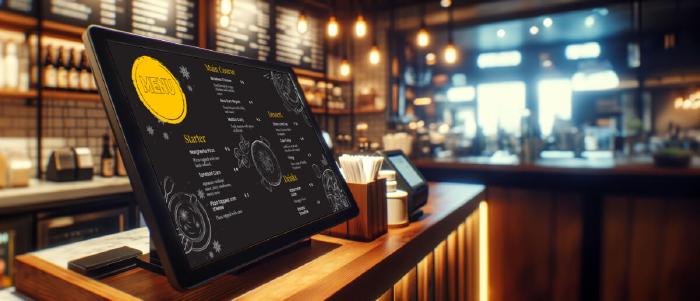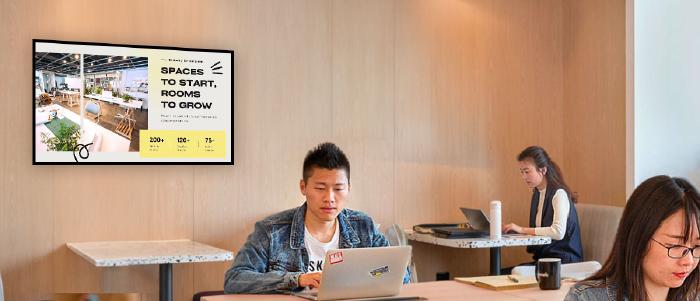
Dec 21 2023
8 min read


Mobile-responsive digital signage software is essential for on-the-go management since it enables content delivery across devices, ensuring real-time updates, seamless user experiences, enhanced collaboration, and versatile content management. As businesses strive to make their mark in the digital landscape, the need for effective communication and screen-friendly dynamic signage has never been more crucial.
Mobile-responsive digital signage is a technology that tailors visual content to different screen sizes and orientations, ensuring adaptability. It equips businesses to generate, oversee, and showcase content across diverse monitors such as LCD or LED displays, interactive kiosks, digital bulletin boards, etc.
Unlike traditional digital signage solutions that lack screen adaptability and updates to big screens using your cell phone, this software empowers real-time changes from and to all devices, aligning with the preferences of contemporary audiences. Industries like retail, hospitality, and events thrive on these benefits, amplifying customer interactions and experiences.
Also read: 17 signs of user-friendly digital signage

Remote content scheduling ensures your messaging remains current and aligned with your business objectives.
Industries where it is valid
Retail: Adapt promotions based on real-time trends.
Hospitality: Update guest information or event schedules.
Education: Up-to-the-minute announcements.
Corporate: Brings agility by disseminating vital information on time.
Transportation: Updates for schedules and announcements, enhancing passenger experience.
Mobile-responsive digital signage software can integrate with various marketing tools and platforms showing CRM portals or KPI data.
It streamlines workflows by automating content updates, saving time and effort.
Industries where it is valid
Healthcare: Allows displaying patient information, doctor availability, healthcare updates, and flash emergency messages.
Entertainment venues: Theater halls, amusement parks, etc., can coordinate promotions with ticketing platforms, enhancing engagement.
It makes collaborations easy. It helps assign roles, control access levels, and track contributions.
Industries where it is valid
Corporate: Streamlined content creation ensures productivity and consistency.
Integrating multimedia elements, like videos, images, and animations enhances visual appeal and engagement potential.
Industries where it is valid
Retail: Dynamic visuals create immersive experiences, conveying product information, promotions, and branding messages.

Enables businesses to tailor their messaging to specific regions or individual displays. It ensures that content remains relevant.
Industries where it is valid
Restaurants: Crucial for franchise marketing. Restaurants can customize their messaging to regions or outlets. The content appeals to the local audience and bridges the gap between digital promotions and the physical dining experience.
Mobile-responsive, digital signage software improves wayfinding experiences in expansive public venues such as retail stores and events by delivering real-time directions and locations of specific places.
Industries where it is valid
Transportation: Provides real-time traffic condition updates, thereby smoothening navigation.
Implements multi-factor authentication and data encryption techniques, unlike standard signage security measures. It ensures that only authorized personnel can access and modify content.
Industries where it is valid
Healthcare: Vital since it involves sensitive patient information. Encryption, authentication protocols, and regular updates ensure that data remains secure.
Businesses can elevate customer experiences through IoT integration that detects customer presence and preferences: this data triggers tailored promotions or interactive maps.
Industries where it is valid
Hospitality: Sensors detect guests’ walk-in times and display personalized welcome messages, local event recommendations, and even directions to their rooms.
Mobile-responsive digital signage software can significantly up cost savings. There are no costs for printing and re-printing content; it can adapt to any screen size and type.
Industries where it is valid
Quick-Service Restaurants (QSRs): Showcase targeted promotions based on real-time demand can help boost upselling and cross-selling. This amplifies ROI.
Here are some renowned brands that have successfully used mobile-responsive software for on-the-go management:
1. McDonald’s: McDonald’s has implemented digital menu boards and interactive ordering kiosks worldwide. This mobile-friendly signage enables them to remotely change and update their menu, promotional content, seasonal offers, and pricing in real-time, ensuring consistency across all locations.

2. TUI: Since 2015, TUI Group, the world’s most extensive tourism company, has embraced mobile-responsive signage technology for on-the-go management. The store concept captivates audiences via atmospheric images on video walls and then guides them to multi-touch tables for interactive exploration of travel options through videos and pictures. The tables also facilitate guided digital tours, combining visuals with interactions.
3. Hilton Hotels: Hilton Hotels has embraced the power of mobile-responsive digital signage software to elevate guest engagement across their properties. From dynamic lobby displays to interactive self-check-in kiosks, Hilton utilizes this technology to communicate event details, conference schedules, amenities, and vital guest information effortlessly.

4. Sephora: As customers navigate Sephora’s tech-infused stores in Germany, Italy, and Switzerland, they meet a blend of innovation and beauty. As visitors enter, dynamic video walls smoothly shift to showcase live promotions, new arrivals, and expert beauty tips. Strategically placed interactive touchscreens showcase detailed product info, view tutorials, and virtually try cosmetics, creating an un-parallel experience.
The mobile responsive digital signage enables orchestrating content, from vibrant visuals to timely announcements. Whether announcing an upcoming makeup masterclass or spotlighting a limited-time offer, the technology’s scalability ensures that the message resonates with each shopper’s unique journey.

Mobile-responsive digital signage software is essential for managing on the go. However, businesses face numerous challenges. But we have got you covered with the remedies as well! Read on.
Challenges
Ensuring content adapts to various screen sizes and orientations can be challenging.
Compatibility issues with different devices and operating systems may arise, hindering seamless functionality.
Balancing the convenience of remote management with digital signage security concerns poses a potential challenge.
Staff may need time to learn and adapt to the new software, impacting initial productivity.
Integrating existing tools and platforms may require technical expertise and resources.
Remedies
Utilize responsive design templates to simplify content adaptation across different screens and resolutions.
Rigorous testing across devices and platforms before deployment can identify and address compatibility issues.
Employ secure communication protocols and encryption to safeguard remote management activities.
Provide comprehensive training and ongoing support to help staff quickly become proficient with the software.
Collaborate closely with software vendors and IT experts to ensure smooth integration with existing systems.
In the 2023 tech dynamic, engagement and flexibility are paramount, and embracing mobile-responsive digital signage software is a strategic necessity. The technology empowers businesses across industries to communicate, captivate, and connect with their audience on the move.
Mobile-responsive digital signage software enhances customer engagement by enabling real-time updates, interactive experiences, and dynamic content delivery. It fosters a new era of efficient and impactful management. So, if you are into tech (which barely anyone isn’t), you must embrace adaptability.

Dec 21 2023
8 min read

Dec 19 2023
8 min read

Dec 14 2023
8 min read

Dec 8 2023
8 min read
Take complete control of what you show on your digital signage & how you show it.
Start Free Trial Schedule My Demo